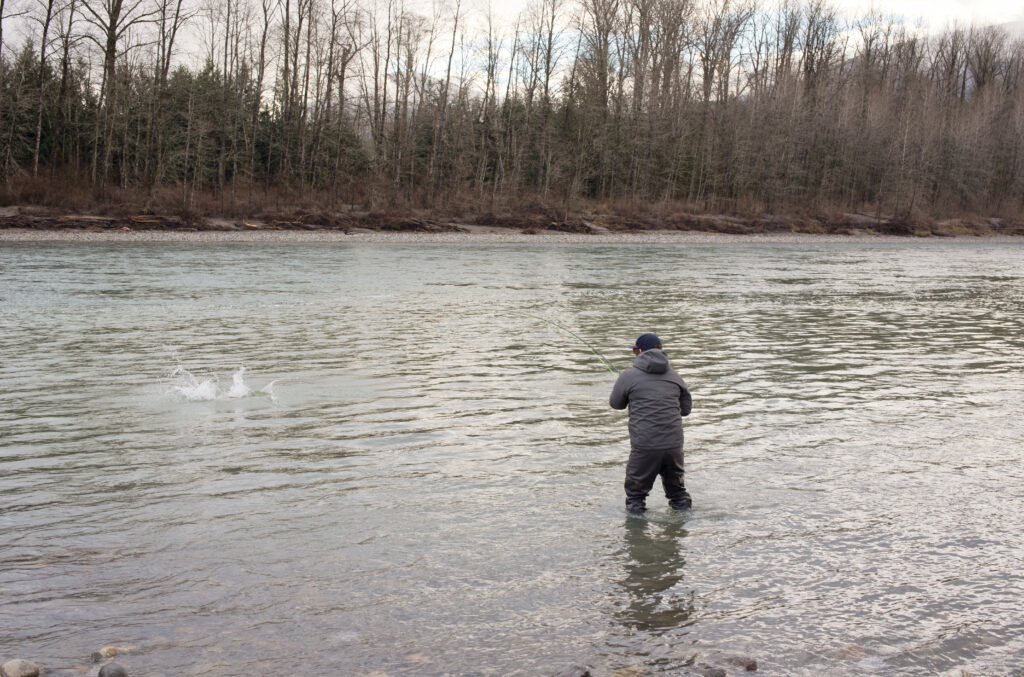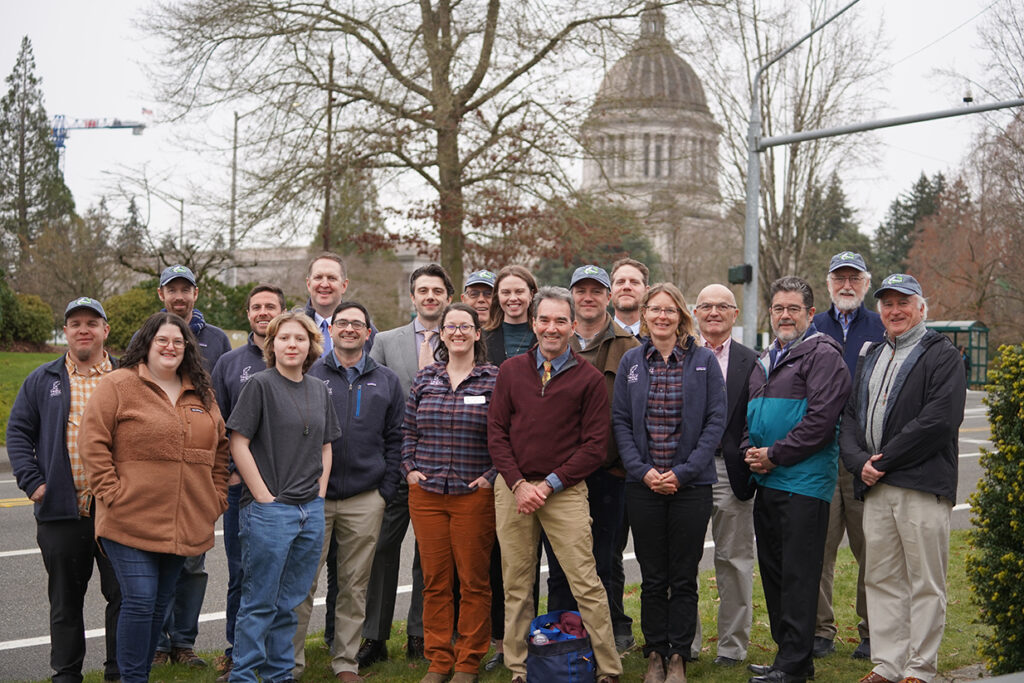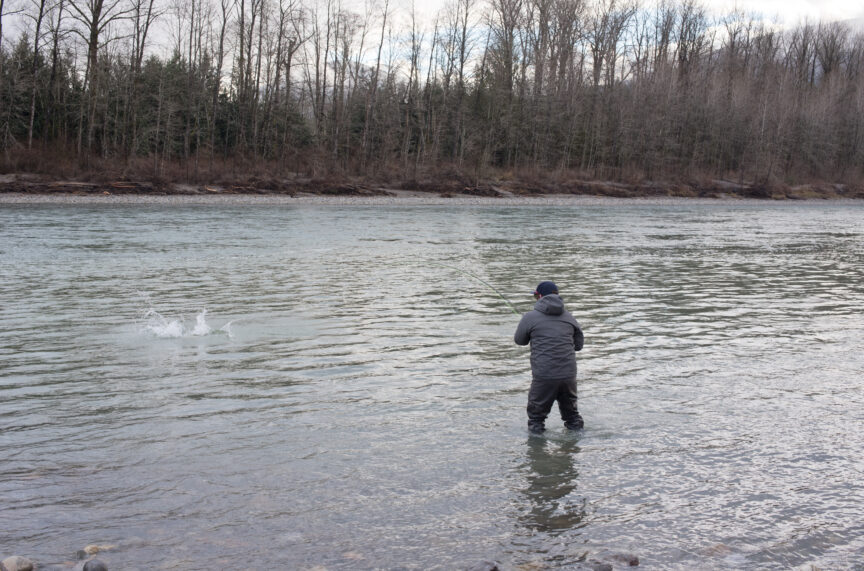
Proposed cuts pose risk to WDFW steelhead fisheries and other vital programs
As Washington’s 2024/2025 winter steelhead season comes to an end, many anglers and guides are squeezing what they can out of the last few weeks of the season on Puget Sound’s Skagit River. The popular catch and release fishery closes April 15.
The Skagit and Sauk season has opened six of the last eight years thanks to a modernized river-specific management plan supported by intensive creel monitoring. The unique fishery plan is managed each year by Washington State and Tribal co-managers, but is guided by NOAA recovery parameters because Puget Sound Steelhead have been listed under the Endangered Species Act since 2007.
However, this important wild steelhead fishing opportunity is currently at-risk of going unfunded in legislative proposals for the Washington Department of Fish and Wildlife’s (WDFW) 2025 – 2027 operating budget.
If the WDFW budget to cover the required fishery monitoring in the Skagit River is not funded by the state legislature, there will not be a Skagit winter-spring steelhead fishery in the foreseeable future.
To be clear, this budget shortfall is not limited to just WDFW. Proposed cuts, like those being considered for the Skagit fishery monitoring, extend across all state agencies. Collectively, Washington State faces a projected $15-billion budget shortfall this legislative session, which means big cuts for state natural resource spending.
How Did We Get Here?
Washington State, unlike the Federal government, must pass a balanced budget. That balance is calculated on a four-year rolling basis, so the next four years of state expenditure must match the next four years of forecasted state revenues. Unfortunately, this year’s projections are short by roughly $15 billion.
To add perspective, the entire annual budgets of all Washington State natural resource agencies combined only amounts to $1.8 billion per year.
Since January, the Washington legislature has been busy in Olympia working on a balanced state budget for the next two years. Both the State Senate and House each pass their own budget, and then the two bodies negotiate the differences between the two proposals. Items that don’t appear in either budget proposal face a huge risk of not being funded, while items funded in only one proposal will face heavy negotiations.
Quicksilver Portfolio
In 2017, WDFW staff and the Puget Sound Steelhead Advisory Group—a group of anglers, scientists, conservation leaders (including Trout Unlimited staff), local residents, guides, and other steelhead supporters—embarked on an unprecedented task to develop a portfolio of watershed-specific conservation, fishery, and hatchery strategies for Puget Sound steelhead.
This management document, the Quicksilver Portfolio, was adopted by the Fish and Wildlife Commission in 2020, put forth to the state legislature as a funding request for $1.6M in the 2021-2023 biennium, and to-date has been successfully funded in each budget since for a total of $8.1M.
We believe the Quicksilver Portfolio is a critical piece of Washington’s steelhead fisheries and recovery efforts for Puget Sound and have always worked hard to support it in the Washington Legislature. Many of the recommendations contained within Quicksilver—from monitoring steelhead abundance and fisheries to improving hatchery operations— are now at-risk of ending, including the renowned Skagit River winter-spring steelhead fishery.

Above: Trout Unlimited staff and volunteers at their 2025 Advocacy Day in Olympia.
What Can You Do?
Last week, both chambers in the state legislature introduced proposed operating budgets for the 2025-2027 biennium, which includes recommendations for funding WDFW. While the operating budget proposed by WDFW last September included $1.6M for “Puget Sound Salmon and Steelhead Monitoring” (i.e. Quicksilver funding), the two budgets proposed last week by the Senate and House of Representatives did not include any funding to continue implementation of the Quicksilver Portfolio and is likely to be cut without significant public input. If you’ve enjoyed the return of the Skagit River steelhead fishery and would like to see other steelhead fishing opportunities return to Puget Sound, here’s what you can do:
Who to Contact
- Contact your State Senator and Representatives. You can find who those are and their contact information here: https://app.leg.wa.gov/districtfinder
- Additionally, you can contact key State Natural Resources and budget leads in the legislature:
- House: Rep. Reeves (D-30), and Rep. Fitzgibbon (D-34)
- Senate: Sen. Chapman (D-24), and Sen. Muzzall (R-10)
What to say
- Fund the ‘Puget Sound Salmon and Steelhead Monitoring’ at $1.6M in the WDFW’s operating budget
- Highlight that this is not a new funding item, and has been funded in every budget since 2021
- The fishery provides conservation benefits and fishing opportunity for both recreational and tribal fisheries in the Skagit River
- Include any reasons why the Skagit River fishery and Puget Sound steelhead are important to you
- Remember: emails are good and phone calls to legislators are even better
Other WDFW Budget Items at Risk
Unfortunately, this year’s budget cuts don’t stop with Quicksilver Portfolio and Skagit fishery.
Below are several other critical programs cut in one or both of the WDFW proposed operating budgets currently being negotiated in the Legislature.
When you contact legislators, these are other items to mention:
- Columbia River ESA Permitting: Provides continued funding to update WDFW’s required ESA permits for their Mid-Columbia tributary fisheries with NOAA. WDFW’s existing suite of fishery permits were developed over the past two decades and currently do not provide full ESA coverage, a legal requirement to prosecute recreational fisheries. Consequences of not completing fishery permits include increased litigation risk and the inability to open new recreational fisheries.
How much: $1.4M per biennium. Where: Cut in both the House and Senate operating budgets.
- Hatchery Production Evaluation: Funding source implemented in 2022 to better monitor and evaluate hatchery production levels, hatchery survival rates, returns, and interactions with wild fish. This funding is critical for operation efficiency, ensure legal and regulatory compliance, and to reduce some of the negative impacts of hatchery production on wild fish populations.
How much: $4.42M per biennium. Where: Cut in House operating budget.
- Enforcement Funding: Funding for game wardens is reduced. Cut in the House budget.
How much: $1M per biennium. Where: Cut in House operating budget.
- Biodiversity Funding: Funding for WDFW biodiversity and species recovery initiative.
How much: $4M per biennium. Where: Cut in Senate operating budget.
- ALEA Volunteer Funding The ALEA Grant Program has supported hundreds of individuals and organizations who undertake projects that engage volunteers and benefit fish and wildlife resources.
How much: $900,000 per biennium. Where: Cut in both House and Senate operating budgets.
- Lake Washington Predator Suppression: Funding for suppression of nonnative predators in Lake Washington to increase survival for Chinook and sockeye, leading to increased adult returns.
How much: $1.4M per biennium. Where: Cut in both House and Senate operating budgets.
This year, it is especially important for wild steelhead anglers and conservationists to speak up in support of the Quicksilver Portfolio, the popular Skagit winter-spring fishery, and other programs that support the recovery and protection of Washington’s wild steelhead and salmon.
For any questions around the legislative budget proposals or about contacting legislators, please contact me: alexei.calambokidis@tu.org.


